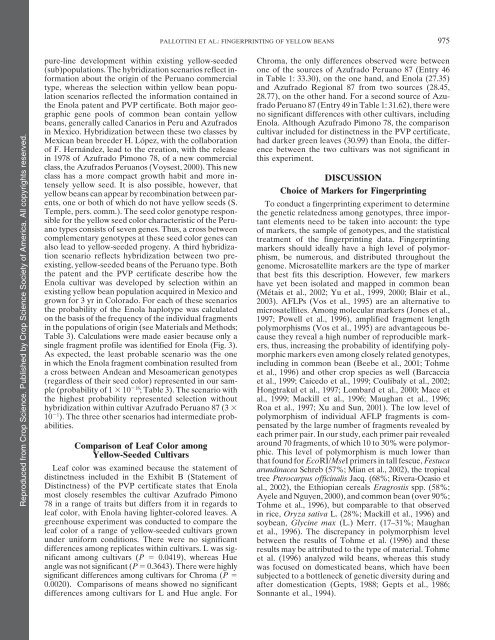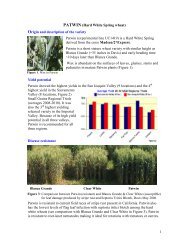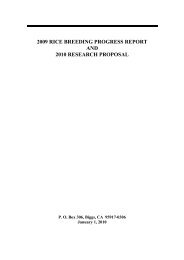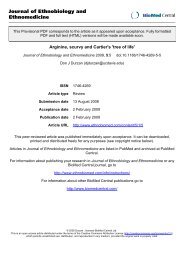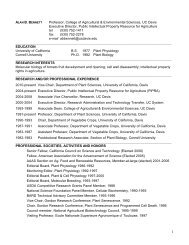plant genetic resources - Department of Plant Sciences - University ...
plant genetic resources - Department of Plant Sciences - University ...
plant genetic resources - Department of Plant Sciences - University ...
Create successful ePaper yourself
Turn your PDF publications into a flip-book with our unique Google optimized e-Paper software.
Reproduced from Crop Science. Published by Crop Science Society <strong>of</strong> America. All copyrights reserved.<br />
PALLOTTINI ET AL.: FINGERPRINTING OF YELLOW BEANS 975<br />
pure-line development within existing yellow-seeded Chroma, the only differences observed were between<br />
(sub)populations. The hybridization scenarios reflect in- one <strong>of</strong> the sources <strong>of</strong> Azufrado Peruano 87 (Entry 46<br />
formation about the origin <strong>of</strong> the Peruano commercial in Table 1: 33.30), on the one hand, and Enola (27.35)<br />
type, whereas the selection within yellow bean popu- and Azufrado Regional 87 from two sources (28.45,<br />
lation scenarios reflected the information contained in 28.77), on the other hand. For a second source <strong>of</strong> Azu-<br />
the Enola patent and PVP certificate. Both major ge<strong>of</strong>rado Peruano 87 (Entry 49 in Table 1: 31.62), there were<br />
graphic gene pools <strong>of</strong> common bean contain yellow no significant differences with other cultivars, including<br />
beans, generally called Canarios in Peru and Azufrados Enola. Although Azufrado Pimono 78, the comparison<br />
in Mexico. Hybridization between these two classes by cultivar included for distinctness in the PVP certificate,<br />
Mexican bean breeder H. López, with the collaboration had darker green leaves (30.99) than Enola, the differ<strong>of</strong><br />
F. Hernández, lead to the creation, with the release ence between the two cultivars was not significant in<br />
in 1978 <strong>of</strong> Azufrado Pimono 78, <strong>of</strong> a new commercial<br />
class, the Azufrados Peruanos (Voysest, 2000). This new<br />
this experiment.<br />
class has a more compact growth habit and more intensely<br />
yellow seed. It is also possible, however, that<br />
yellow beans can appear by recombination between par-<br />
DISCUSSION<br />
Choice <strong>of</strong> Markers for Fingerprinting<br />
ents, one or both <strong>of</strong> which do not have yellow seeds (S.<br />
Temple, pers. comm.). The seed color genotype responsible<br />
for the yellow seed color characteristic <strong>of</strong> the Peruano<br />
types consists <strong>of</strong> seven genes. Thus, a cross between<br />
complementary genotypes at these seed color genes can<br />
also lead to yellow-seeded progeny. A third hybridization<br />
scenario reflects hybridization between two preexisting,<br />
yellow-seeded beans <strong>of</strong> the Peruano type. Both<br />
the patent and the PVP certificate describe how the<br />
Enola cultivar was developed by selection within an<br />
existing yellow bean population acquired in Mexico and<br />
To conduct a fingerprinting experiment to determine<br />
the <strong>genetic</strong> relatedness among genotypes, three impor-<br />
tant elements need to be taken into account: the type<br />
<strong>of</strong> markers, the sample <strong>of</strong> genotypes, and the statistical<br />
treatment <strong>of</strong> the fingerprinting data. Fingerprinting<br />
markers should ideally have a high level <strong>of</strong> polymor-<br />
phism, be numerous, and distributed throughout the<br />
genome. Microsatellite markers are the type <strong>of</strong> marker<br />
that best fits this description. However, few markers<br />
have yet been isolated and mapped in common bean<br />
(Métais et al., 2002; Yu et al., 1999, 2000; Blair et al.,<br />
grown for 3 yr in Colorado. For each <strong>of</strong> these scenarios 2003). AFLPs (Vos et al., 1995) are an alternative to<br />
the probability <strong>of</strong> the Enola haplotype was calculated microsatellites. Among molecular markers (Jones et al.,<br />
on the basis <strong>of</strong> the frequency <strong>of</strong> the individual fragments 1997; Powell et al., 1996), amplified fragment length<br />
in the populations <strong>of</strong> origin (see Materials and Methods; polymorphisms (Vos et al., 1995) are advantageous be-<br />
Table 3). Calculations were made easier because only a cause they reveal a high number <strong>of</strong> reproducible marksingle<br />
fragment pr<strong>of</strong>ile was identified for Enola (Fig. 3). ers, thus, increasing the probability <strong>of</strong> identifying poly-<br />
As expected, the least probable scenario was the one morphic markers even among closely related genotypes,<br />
in which the Enola fragment combination resulted from including in common bean (Beebe et al., 2001; Tohme<br />
a cross between Andean and Mesoamerican genotypes et al., 1996) and other crop species as well (Barcaccia<br />
(regardless <strong>of</strong> their seed color) represented in our sam- et al., 1999; Caicedo et al., 1999; Coulibaly et al., 2002;<br />
ple (probability <strong>of</strong> 1 � 10 Hongtrakul et al., 1997; Lombard et al., 2000; Mace et<br />
�18 ; Table 3). The scenario with<br />
the highest probability represented selection without al., 1999; Mackill et al., 1996; Maughan et al., 1996;<br />
hybridization within cultivar Azufrado Peruano 87 (3 � Roa et al., 1997; Xu and Sun, 2001). The low level <strong>of</strong><br />
10 polymorphism <strong>of</strong> individual AFLP fragments is com-<br />
�1 ). The three other scenarios had intermediate prob-<br />
abilities.<br />
pensated by the large number <strong>of</strong> fragments revealed by<br />
each primer pair. In our study, each primer pair revealed<br />
Comparison <strong>of</strong> Leaf Color among<br />
Yellow-Seeded Cultivars<br />
Leaf color was examined because the statement <strong>of</strong><br />
distinctness included in the Exhibit B (Statement <strong>of</strong><br />
Distinctness) <strong>of</strong> the PVP certificate states that Enola<br />
most closely resembles the cultivar Azufrado Pimono<br />
78 in a range <strong>of</strong> traits but differs from it in regards to<br />
leaf color, with Enola having lighter-colored leaves. A<br />
greenhouse experiment was conducted to compare the<br />
leaf color <strong>of</strong> a range <strong>of</strong> yellow-seeded cultivars grown<br />
under uniform conditions. There were no significant<br />
differences among replicates within cultivars. L was sigaround<br />
70 fragments, <strong>of</strong> which 10 to 30% were polymorphic.<br />
This level <strong>of</strong> polymorphism is much lower than<br />
that found for EcoRI/MseI primers in tall fescue, Festuca<br />
arundinacea Schreb (57%; Mian et al., 2002), the tropical<br />
tree Pterocarpus <strong>of</strong>ficinalis Jacq. (68%; Rivera-Ocasio et<br />
al., 2002), the Ethiopian cereals Eragrostis spp. (58%;<br />
Ayele and Nguyen, 2000), and common bean (over 90%;<br />
Tohme et al., 1996), but comparable to that observed<br />
in rice, Oryza sativa L. (28%; Mackill et al., 1996) and<br />
soybean, Glycine max (L.) Merr. (17–31%; Maughan<br />
et al., 1996). The discrepancy in polymorphism level<br />
between the results <strong>of</strong> Tohme et al. (1996) and these<br />
results may be attributed to the type <strong>of</strong> material. Tohme<br />
nificant among cultivars (P � 0.0419), whereas Hue et al. (1996) analyzed wild beans, whereas this study<br />
angle was not significant (P � 0.3643). There were highly was focused on domesticated beans, which have been<br />
significant differences among cultivars for Chroma (P � subjected to a bottleneck <strong>of</strong> <strong>genetic</strong> diversity during and<br />
0.0020). Comparisons <strong>of</strong> means showed no significant after domestication (Gepts, 1988; Gepts et al., 1986;<br />
differences among cultivars for L and Hue angle. For<br />
Sonnante et al., 1994).


